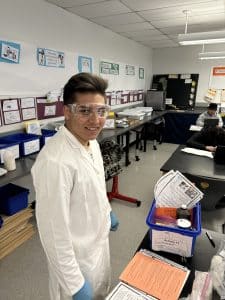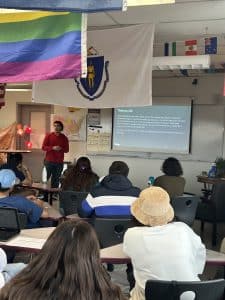The Evolution of a Competency-Based Academic Model at Chelsea Opportunity Academy
CompetencyWorks Blog
This post is the second in a series about Chelsea Opportunity Academy (COA) in Chelsea, MA, which serves 150 students, many who were not on track to graduate from high school when they enrolled at COA as a result of not being served well educationally in traditional schools for a variety of reasons.
This past summer, the team at COA was busy aligning their courses to their revised competency framework. I heard about this work when I first visited last December and had the opportunity to touch base as they were getting ready to use their revised framework in the current school year.
From its inception in 2018, COA has always been competency-based, but its model continues to evolve. This post shares the latest update to the COA competency framework and the journey that enabled it.
Competency-Based from the Start, With Early Lessons to Learn

Looking back on their first year, Assistant Principal Adam Aronson reflected on how COA started with what they thought was CBE curriculum. They had many components, including mastery-based performance assessments and skills-based rubrics. However, after much reflection, their staff realized that their courses were still highly traditional at their core. First, courses were linear in nature with all students learning the same things at the same time. Next, they were based almost entirely on content and did not emphasize transferable skills that could be used across disciplines and contexts. Finally, traditional names such as “US History 2” did not spark images of meaningful assessment and active learning.
In year two, they reworked their entire curriculum to be arranged by “coursitos” – shorter, focused mini-courses that are aligned to a specific competency and each worth one credit. Coursitos created greater flexibility for students and allowed for a variety of topics that are relevant to students. Two students can enroll and work on the same coursito at the same time, but each receives personalized support. The coursito structure is mastery-based at its core. Each of the individual assignments teaches a new skill that may be useful for the student on their final performance assessment. If a student understands the skills, they move on to the next assignment. If they do not, they continue learning and revise until they and their teacher feel they are ready to move on.
Each student selects their own individual set of coursitos. During my visit, students navigated the LMS (learning management system) with ease as they showed me what they were working on, which included coursitos such as Gentrification in Chelsea, Chemistry: How ARE Cars so Fast and Furious?, and English – for my Health! The LMS also tracks progress towards demonstration of competency in each course as well as producing the student transcript.
The Continuing Evolution of the Competency Framework
At the end of their fourth year of operation, COA staff reached two startling conclusions. First, they realized that the complexity of the school’s competency set made it too difficult for students to understand. There were 15 competencies, each with multiple subskills that students needed to demonstrate competency separately. Perhaps more concerning, COA staff realized that they themselves were not very clear on these essential components of the school’s academic model.
The main goal of COA staff’s most recent project was to streamline the competencies so that they are more easily internalized into students’ experiences of their learning. History teacher Christian Kelley reflected last December, “we need to better integrate the competencies in a formative way so students can see their own growth before they actually get assessed on [them].” With so many original competencies, most students did not see all of them multiple times. They couldn’t easily see their growth across time or how the competencies apply in different contexts. “The model didn’t really fit as is, so we asked: What skills do we want students to leave with?” said Christian.
This most recent revision journey started last school year with visits to three schools in NYC – Bronx Arena, Urban Assembly Maker Academy, and The Young Women’s Leadership School (TYWLS). While staff gained insights, in the end, they did not find a model to adopt. They continued to dig deeper and explored other sets of competencies – some streamlined and student-facing and others with over 200 nuanced performance indicators for mastery. After much reflection on their learning and assessment of student need, the COA instructional staff chose to adapt Springpoint’s six competency areas. The COA team felt the structure fit better with COA’s unique population and model, where they have students for different periods of time learning at COA based on their prior credits and when they arrive as COA students.
The new COA competencies include the following six areas. For each area, there are attainments (like subskills) that can be adapted to match the specific performance assessment tasks of each coursito. 
- Argue
- Communicate
- Analyze
- Self-direct
- Collaborate
- Investigate
Adam Aronson shares, “With this set of competencies, there is a big shift towards intentionality. What I mean by that is these skills that we created are the skills that we want our students to learn and master. This creates the foundation of our portrait and vision of a COA graduate. They are the essential skills and we’ve made it so that in each course our students understand those skills.”
Flexible and Effective
To ensure that students have all the tools they need to learn and demonstrate competencies, the system provides structures and processes for teachers to support students, be flexible, and hold high expectations. Competencies and rubrics provide a backbone for the quality of the system.
At COA, teachers regularly collaborate in a number of activities that refine their shared understanding of the expectations for student performance. They analyze coursito performance assessments and rubric look-fors for alignment to the competencies, especially for the “functional” level, which denotes the level of competency required to earn credit. Over the years, they have scored work together and created a bank of exemplars that illustrate what clear demonstration looks like at “functional” and “nuanced” (advanced) levels. For example, Jay Jay Pina, a graduate who will share her story in the fourth post of this series, wrote a narrative piece about an incident in the community that lives on as a “nuanced” exemplar for the “convey voice” competency (from the prior framework).

In each coursito, COA students demonstrate the mastery of a competency. By the time they graduate, even students who transfer to COA late in their careers will have the opportunity to demonstrate mastery in each competency. The COA Senior Capstone serves as a moment to reflect on whether a student is ready to graduate. When we spoke in mid-September, the first capstone of the school year had just wrapped up and the graduation gong was still vibrating in the hallway. (What could be a better example of CBE’s embrace of responsive pacing than a student graduating in mid-September?!) Aronson shares that “the entire purpose of capstone is for students to evaluate the claim: I am ready to graduate from COA. Students support that claim using evidence from inside and outside COA.” Capstones are also a moment for the staff to calibrate their expectations of this culminating evidence.
Aronson and the three teachers I spoke with in August see the new competency framework as strengthening the alignment of the COA way of teaching, learning, and assessing. Aronson summarizes the journey, “If the student can do their capstone to articulate their vision of themselves, using the evidence of the competencies, and each coursito helps students produce quality evidence, and each task and experience builds to the competency, we can ensure quality, even though we may only have a student for a short time.”
Some students need more coaching than others, and the COA staff continues to work towards cultivating student ownership and agency in their learning through to their graduation capstone. With the new competency framework, the COA staff envisions that the competencies and rubrics will go beyond setting a unified standard of excellence by the staff. As Aronson explains, “ideally the rubrics will also inspire metacognition for students. They will not only understand the skills needed to succeed but also how they can best improve and grow.”
Validating the System
On a macro level, COA also looks at a range of data to determine what is working or needs attention to ensure alignment and quality. For example, data on student progress and achievement include data within the system such as students’ rate and pace of course completion as well as external data such as passing rates on standardized tests. COA leaders also collect data to give insights into the success of its graduates. Examples include information on graduates’ post-secondary plans, such as college acceptance and attendance or other plans, and whether they stay in those pathways. Currently, COA has a 144 strong and growing alumni database of quantitative and qualitative indicators to help them know whether they are meeting the needs of COA students.
Collaborative Structures Enable the Work
Collaboration is an integral part of the design and implementation of the systems and practices at COA. There is time for a professional learning community (PLC) for the whole staff, that is led by the administrative leaders, where the team often looks at student work and was a time for building the exemplar banks. There is also a critical friend group (CFG) structure for teacher-led collaboration, which is currently led by Christian Kelley, who is a history teacher and a founding teacher at COA.
Kelley described the evolution of the work of the CFG, “We started out in our first year being more about sharing lessons and curriculum, as well as the calibration of tasks…this year, we’ve been thinking about school wide systems and using CFG as a venue to revise our competencies.” The culture and structures of collaboration were a key ingredient in the competency framework revision and the work that teachers engaged in (at a level that teachers self-determined) to align couristos and performance assessments to the newly adopted competencies.
A Continued CBE Journey
COA had a strong system and they see the competency framework project as making that system more transparent and effective. It codifies the process for alignment to the competencies and the structure of the learning scaffolds that support learners in getting to the needed results. On the horizon, the COA team also see next steps for its system such as ensuring full alignment between the competencies and COA’s portrait of a graduate elements – like happiness.
In the next post, we’ll dive deeper into the flexible, competency-based curriculum that flows from COA’s competency framework.
Learn More
- Chelsea Opportunity Academy: Relationships, Flexibility, and Competency-Based from the Start
- The Primary Person Model and Transformative Learning Experiences at Opportunity Academy
- Learning in a Supportive Community at Clark Street Community School
- The Shift In Action: Five Takeaways From Our Journey Towards A Competency-Based System
 Laurie Gagnon is the CompetencyWorks Program Director at the Aurora Institute. She leads the work of sharing promising practices shaping the future of K-12 personalized, competency-based education (CBE).
Laurie Gagnon is the CompetencyWorks Program Director at the Aurora Institute. She leads the work of sharing promising practices shaping the future of K-12 personalized, competency-based education (CBE).